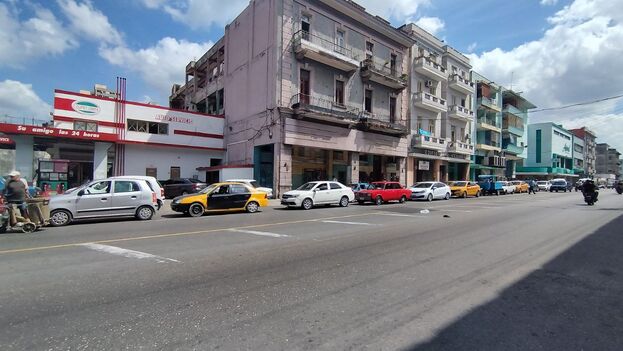
![]() 14ymedio, Natalia López Moya, Havana, 4 March 2023 — The sun itches, although the Lenten winds blow over Havana and ruffle the hair of passers-by. Inside a vehicle, in the long line to buy fuel at the corner of Infanta and San Rafael this Friday, the temperature is similar to what is experienced in the purgatory of May, or even a high that’s reached in the hell of August. “There is no other option, in order to fill the tank you have to get cooked over low heat,” laments a driver who at the stroke of noon had already been in line for two hours .
14ymedio, Natalia López Moya, Havana, 4 March 2023 — The sun itches, although the Lenten winds blow over Havana and ruffle the hair of passers-by. Inside a vehicle, in the long line to buy fuel at the corner of Infanta and San Rafael this Friday, the temperature is similar to what is experienced in the purgatory of May, or even a high that’s reached in the hell of August. “There is no other option, in order to fill the tank you have to get cooked over low heat,” laments a driver who at the stroke of noon had already been in line for two hours .
The cars almost touch. There’s a garish red Lada that a few years ago would have targeted its owner as a vice-minister or colonel; a tricycle to transport goods; several modern Citroëns that seem older than any almendrón* from the last century and even a taxi that demands 30 dollars to shuttle travelers who have recently arrived at the José Martí airport to the city. It doesn’t matter the year of manufacture, the state of the body, or the pedigree of the driver. They are all scorching equally under the sun.
“I no longer go around in circles. I come directly to gas stations on the main avenues, which are the best supplied ones,” the driver of a Russian-made Moskvitch with nickel-plated wheels, interior air conditioning and other amenities, though manufactured, as he admits, “in times of the CAME [Council for Mutual Economic Assistance], so it was not designed for savings,” he laments. The owner perceives the fuel supply in the city as a “see saw”: “One day they tell you that there is no problem and you can fill the tank, and the next you can only add a certain number of liters.”
It’s common for people to come to blows when the line slows down or when an employee yells that they’re out of diesel or hot dogs
In addition, several lines converge at the gas station at the popular corner of Centro Habana. The place has a small store that sells frozen products, across from it there is a property belonging to the Rápido chain, an attempt by the Cuban regime to emulate the reviled, by official discourse, McDonald’s and Subway, but it ended up capsizing due to the lack of raw materials and inflation and joined the network of regulated trade. When the day begins, in this nodal point of Centro Habana it is difficult to know who is there for a package of frozen chicken, a bag of detergent or a liter of gasoline.
The avenue, named in honor of Princess María Luisa Fernanda, youngest daughter of King Ferdinand VII and sister of Isabel II of Spain, is lacking in monarchy and has a surplus of misery. It’s common for people to come to blows when the line slows down or when an employee yells that they’re out of diesel or hot dogs. That’s when, in one of the most “royal” of Havana streets, people take off their flip-flops, shout obscenities and seem to be ready for anything. Then the March winds blow and everyone goes home.
*Translator’s note: Almendrón, from the ‘almond shape’ of the vehicles, is a term that refers to mid-20th century American cars, still plying the streets of Cuba, primarily as shared taxis for Cuban customers, and as ‘nostalgic’ tours for foreigners.
____________
COLLABORATE WITH OUR WORK: The 14ymedio team is committed to practicing serious journalism that reflects Cuba’s reality in all its depth. Thank you for joining us on this long journey. We invite you to continue supporting us by becoming a member of 14ymedio now. Together we can continue transforming journalism in Cuba.
